Critical Analysis: Trade Unions and Employment Relations in Australia
VerifiedAdded on 2019/11/25
|12
|2737
|173
Essay
AI Summary
This paper provides a critical analysis of the decline in trade union membership in Australia since the 1980s, exploring the factors that have contributed to their diminishing relevance. The paper defines trade unions and their role, particularly the Australian Council of Trade Unions (ACTU). It examines the reasons for the decline, including managerial hostility, unfavorable legal frameworks, youth indifference, and enterprise bargaining, alongside the changing demographics of the workforce. The paper further discusses the consequences of this decline, affecting workers, unions, and the Australian government, leading to income inequality, compromised work standards, and gender-related pressures. The analysis also covers the financial struggles of unions and the shift in worker affiliations. The paper concludes by emphasizing the need to address the core issues to revitalize trade unions in Australia, offering insights into how countries with thriving unions prioritize worker rights.
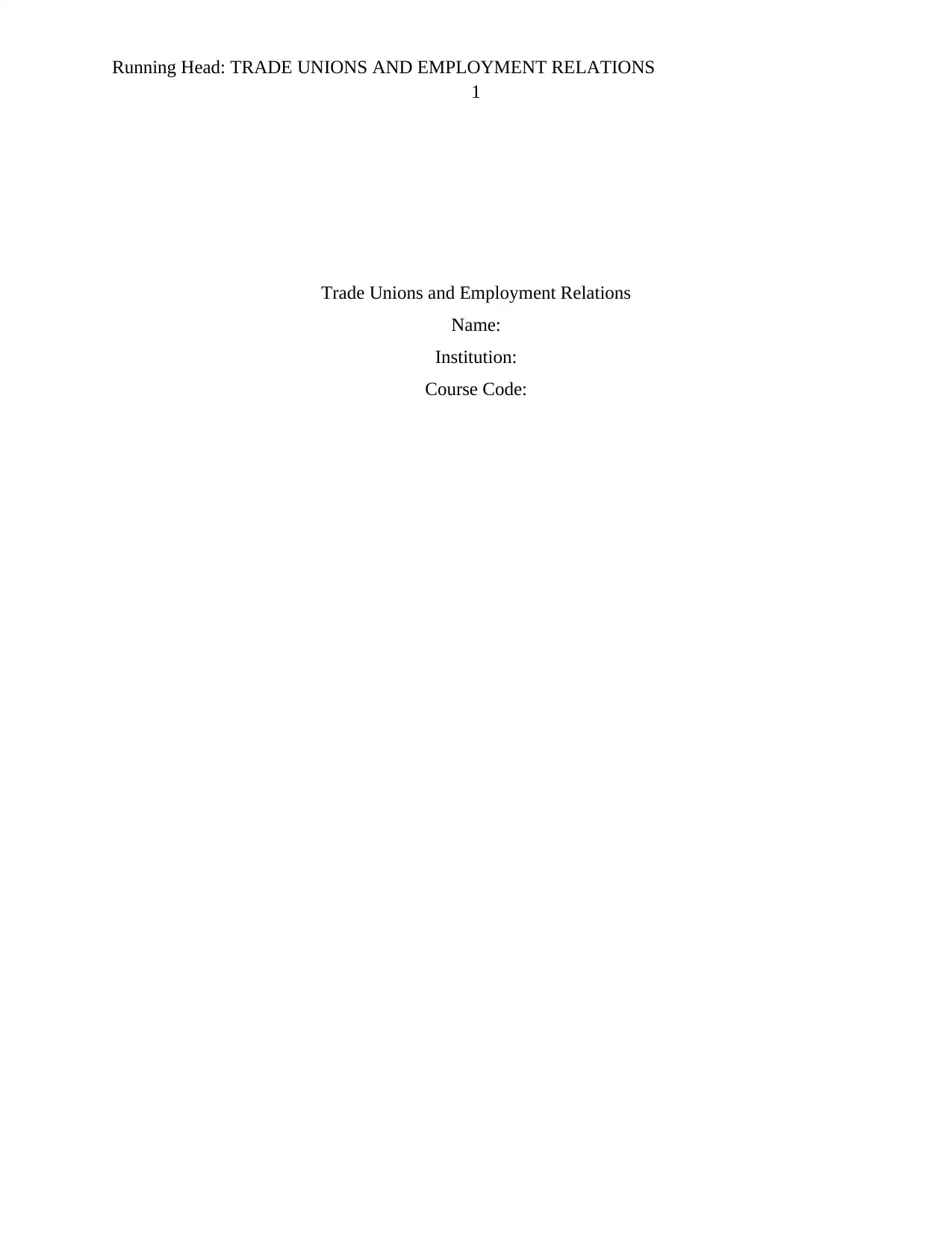
Running Head: TRADE UNIONS AND EMPLOYMENT RELATIONS
1
Trade Unions and Employment Relations
Name:
Institution:
Course Code:
1
Trade Unions and Employment Relations
Name:
Institution:
Course Code:
Paraphrase This Document
Need a fresh take? Get an instant paraphrase of this document with our AI Paraphraser
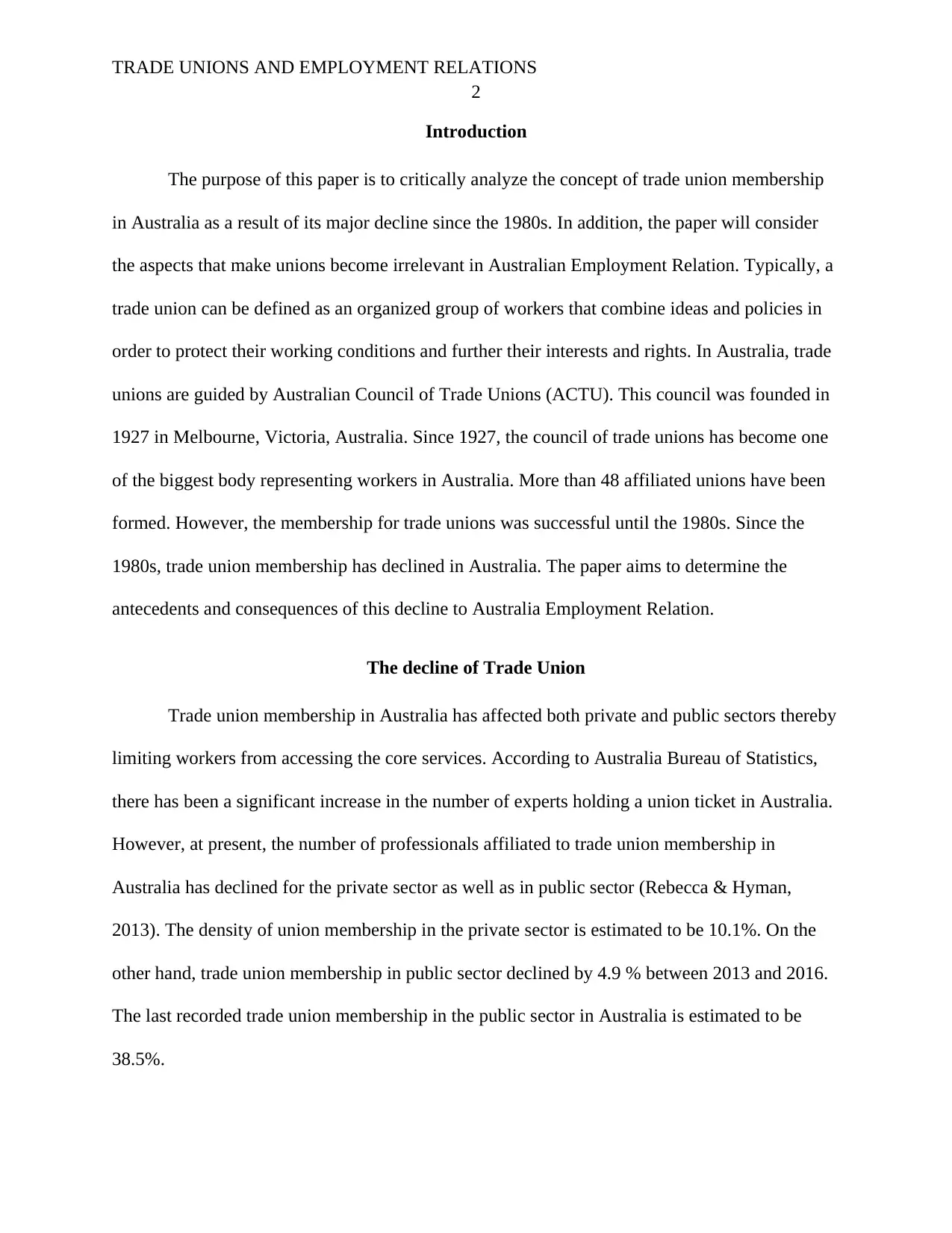
TRADE UNIONS AND EMPLOYMENT RELATIONS
2
Introduction
The purpose of this paper is to critically analyze the concept of trade union membership
in Australia as a result of its major decline since the 1980s. In addition, the paper will consider
the aspects that make unions become irrelevant in Australian Employment Relation. Typically, a
trade union can be defined as an organized group of workers that combine ideas and policies in
order to protect their working conditions and further their interests and rights. In Australia, trade
unions are guided by Australian Council of Trade Unions (ACTU). This council was founded in
1927 in Melbourne, Victoria, Australia. Since 1927, the council of trade unions has become one
of the biggest body representing workers in Australia. More than 48 affiliated unions have been
formed. However, the membership for trade unions was successful until the 1980s. Since the
1980s, trade union membership has declined in Australia. The paper aims to determine the
antecedents and consequences of this decline to Australia Employment Relation.
The decline of Trade Union
Trade union membership in Australia has affected both private and public sectors thereby
limiting workers from accessing the core services. According to Australia Bureau of Statistics,
there has been a significant increase in the number of experts holding a union ticket in Australia.
However, at present, the number of professionals affiliated to trade union membership in
Australia has declined for the private sector as well as in public sector (Rebecca & Hyman,
2013). The density of union membership in the private sector is estimated to be 10.1%. On the
other hand, trade union membership in public sector declined by 4.9 % between 2013 and 2016.
The last recorded trade union membership in the public sector in Australia is estimated to be
38.5%.
2
Introduction
The purpose of this paper is to critically analyze the concept of trade union membership
in Australia as a result of its major decline since the 1980s. In addition, the paper will consider
the aspects that make unions become irrelevant in Australian Employment Relation. Typically, a
trade union can be defined as an organized group of workers that combine ideas and policies in
order to protect their working conditions and further their interests and rights. In Australia, trade
unions are guided by Australian Council of Trade Unions (ACTU). This council was founded in
1927 in Melbourne, Victoria, Australia. Since 1927, the council of trade unions has become one
of the biggest body representing workers in Australia. More than 48 affiliated unions have been
formed. However, the membership for trade unions was successful until the 1980s. Since the
1980s, trade union membership has declined in Australia. The paper aims to determine the
antecedents and consequences of this decline to Australia Employment Relation.
The decline of Trade Union
Trade union membership in Australia has affected both private and public sectors thereby
limiting workers from accessing the core services. According to Australia Bureau of Statistics,
there has been a significant increase in the number of experts holding a union ticket in Australia.
However, at present, the number of professionals affiliated to trade union membership in
Australia has declined for the private sector as well as in public sector (Rebecca & Hyman,
2013). The density of union membership in the private sector is estimated to be 10.1%. On the
other hand, trade union membership in public sector declined by 4.9 % between 2013 and 2016.
The last recorded trade union membership in the public sector in Australia is estimated to be
38.5%.
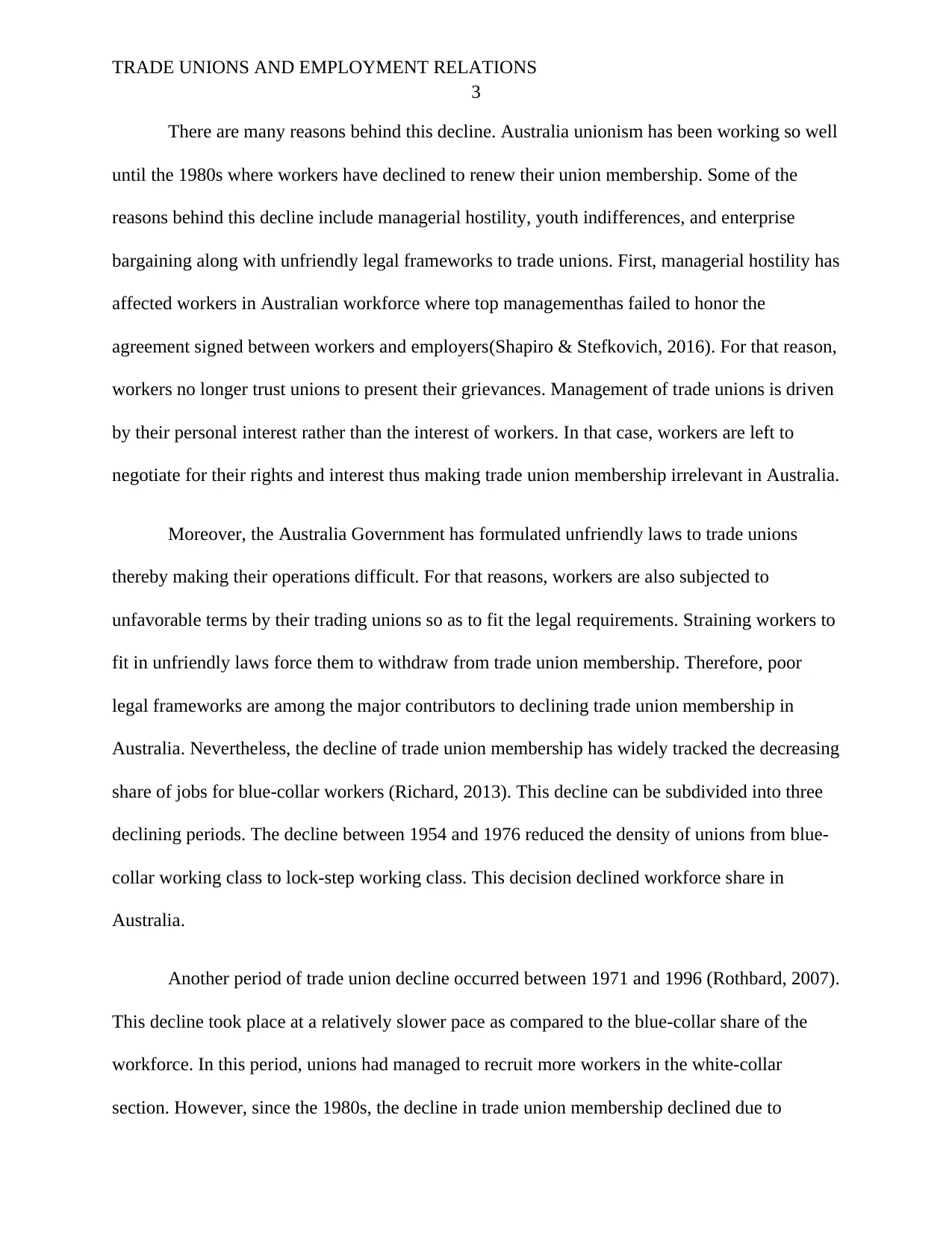
TRADE UNIONS AND EMPLOYMENT RELATIONS
3
There are many reasons behind this decline. Australia unionism has been working so well
until the 1980s where workers have declined to renew their union membership. Some of the
reasons behind this decline include managerial hostility, youth indifferences, and enterprise
bargaining along with unfriendly legal frameworks to trade unions. First, managerial hostility has
affected workers in Australian workforce where top managementhas failed to honor the
agreement signed between workers and employers(Shapiro & Stefkovich, 2016). For that reason,
workers no longer trust unions to present their grievances. Management of trade unions is driven
by their personal interest rather than the interest of workers. In that case, workers are left to
negotiate for their rights and interest thus making trade union membership irrelevant in Australia.
Moreover, the Australia Government has formulated unfriendly laws to trade unions
thereby making their operations difficult. For that reasons, workers are also subjected to
unfavorable terms by their trading unions so as to fit the legal requirements. Straining workers to
fit in unfriendly laws force them to withdraw from trade union membership. Therefore, poor
legal frameworks are among the major contributors to declining trade union membership in
Australia. Nevertheless, the decline of trade union membership has widely tracked the decreasing
share of jobs for blue-collar workers (Richard, 2013). This decline can be subdivided into three
declining periods. The decline between 1954 and 1976 reduced the density of unions from blue-
collar working class to lock-step working class. This decision declined workforce share in
Australia.
Another period of trade union decline occurred between 1971 and 1996 (Rothbard, 2007).
This decline took place at a relatively slower pace as compared to the blue-collar share of the
workforce. In this period, unions had managed to recruit more workers in the white-collar
section. However, since the 1980s, the decline in trade union membership declined due to
3
There are many reasons behind this decline. Australia unionism has been working so well
until the 1980s where workers have declined to renew their union membership. Some of the
reasons behind this decline include managerial hostility, youth indifferences, and enterprise
bargaining along with unfriendly legal frameworks to trade unions. First, managerial hostility has
affected workers in Australian workforce where top managementhas failed to honor the
agreement signed between workers and employers(Shapiro & Stefkovich, 2016). For that reason,
workers no longer trust unions to present their grievances. Management of trade unions is driven
by their personal interest rather than the interest of workers. In that case, workers are left to
negotiate for their rights and interest thus making trade union membership irrelevant in Australia.
Moreover, the Australia Government has formulated unfriendly laws to trade unions
thereby making their operations difficult. For that reasons, workers are also subjected to
unfavorable terms by their trading unions so as to fit the legal requirements. Straining workers to
fit in unfriendly laws force them to withdraw from trade union membership. Therefore, poor
legal frameworks are among the major contributors to declining trade union membership in
Australia. Nevertheless, the decline of trade union membership has widely tracked the decreasing
share of jobs for blue-collar workers (Richard, 2013). This decline can be subdivided into three
declining periods. The decline between 1954 and 1976 reduced the density of unions from blue-
collar working class to lock-step working class. This decision declined workforce share in
Australia.
Another period of trade union decline occurred between 1971 and 1996 (Rothbard, 2007).
This decline took place at a relatively slower pace as compared to the blue-collar share of the
workforce. In this period, unions had managed to recruit more workers in the white-collar
section. However, since the 1980s, the decline in trade union membership declined due to
⊘ This is a preview!⊘
Do you want full access?
Subscribe today to unlock all pages.

Trusted by 1+ million students worldwide
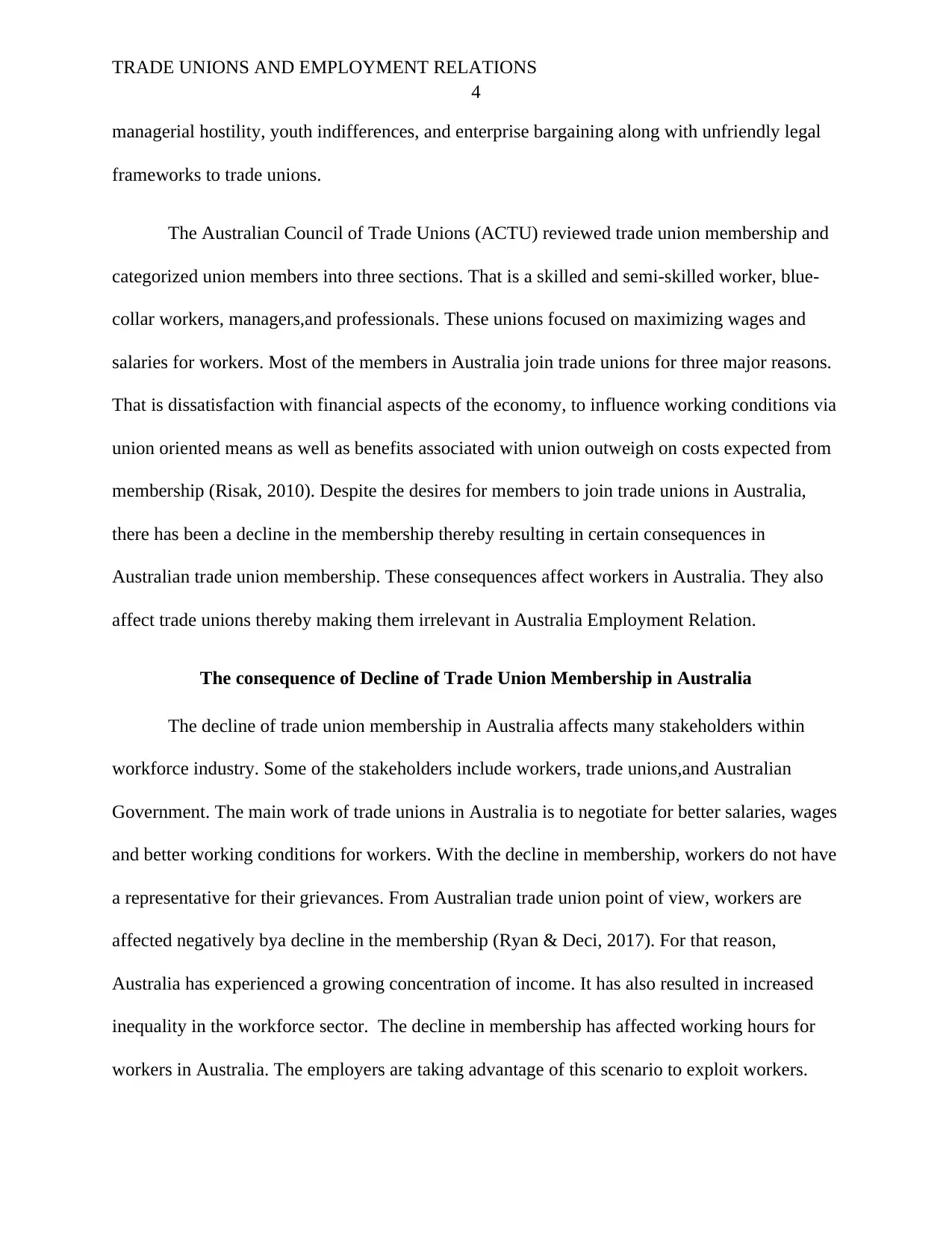
TRADE UNIONS AND EMPLOYMENT RELATIONS
4
managerial hostility, youth indifferences, and enterprise bargaining along with unfriendly legal
frameworks to trade unions.
The Australian Council of Trade Unions (ACTU) reviewed trade union membership and
categorized union members into three sections. That is a skilled and semi-skilled worker, blue-
collar workers, managers,and professionals. These unions focused on maximizing wages and
salaries for workers. Most of the members in Australia join trade unions for three major reasons.
That is dissatisfaction with financial aspects of the economy, to influence working conditions via
union oriented means as well as benefits associated with union outweigh on costs expected from
membership (Risak, 2010). Despite the desires for members to join trade unions in Australia,
there has been a decline in the membership thereby resulting in certain consequences in
Australian trade union membership. These consequences affect workers in Australia. They also
affect trade unions thereby making them irrelevant in Australia Employment Relation.
The consequence of Decline of Trade Union Membership in Australia
The decline of trade union membership in Australia affects many stakeholders within
workforce industry. Some of the stakeholders include workers, trade unions,and Australian
Government. The main work of trade unions in Australia is to negotiate for better salaries, wages
and better working conditions for workers. With the decline in membership, workers do not have
a representative for their grievances. From Australian trade union point of view, workers are
affected negatively bya decline in the membership (Ryan & Deci, 2017). For that reason,
Australia has experienced a growing concentration of income. It has also resulted in increased
inequality in the workforce sector. The decline in membership has affected working hours for
workers in Australia. The employers are taking advantage of this scenario to exploit workers.
4
managerial hostility, youth indifferences, and enterprise bargaining along with unfriendly legal
frameworks to trade unions.
The Australian Council of Trade Unions (ACTU) reviewed trade union membership and
categorized union members into three sections. That is a skilled and semi-skilled worker, blue-
collar workers, managers,and professionals. These unions focused on maximizing wages and
salaries for workers. Most of the members in Australia join trade unions for three major reasons.
That is dissatisfaction with financial aspects of the economy, to influence working conditions via
union oriented means as well as benefits associated with union outweigh on costs expected from
membership (Risak, 2010). Despite the desires for members to join trade unions in Australia,
there has been a decline in the membership thereby resulting in certain consequences in
Australian trade union membership. These consequences affect workers in Australia. They also
affect trade unions thereby making them irrelevant in Australia Employment Relation.
The consequence of Decline of Trade Union Membership in Australia
The decline of trade union membership in Australia affects many stakeholders within
workforce industry. Some of the stakeholders include workers, trade unions,and Australian
Government. The main work of trade unions in Australia is to negotiate for better salaries, wages
and better working conditions for workers. With the decline in membership, workers do not have
a representative for their grievances. From Australian trade union point of view, workers are
affected negatively bya decline in the membership (Ryan & Deci, 2017). For that reason,
Australia has experienced a growing concentration of income. It has also resulted in increased
inequality in the workforce sector. The decline in membership has affected working hours for
workers in Australia. The employers are taking advantage of this scenario to exploit workers.
Paraphrase This Document
Need a fresh take? Get an instant paraphrase of this document with our AI Paraphraser
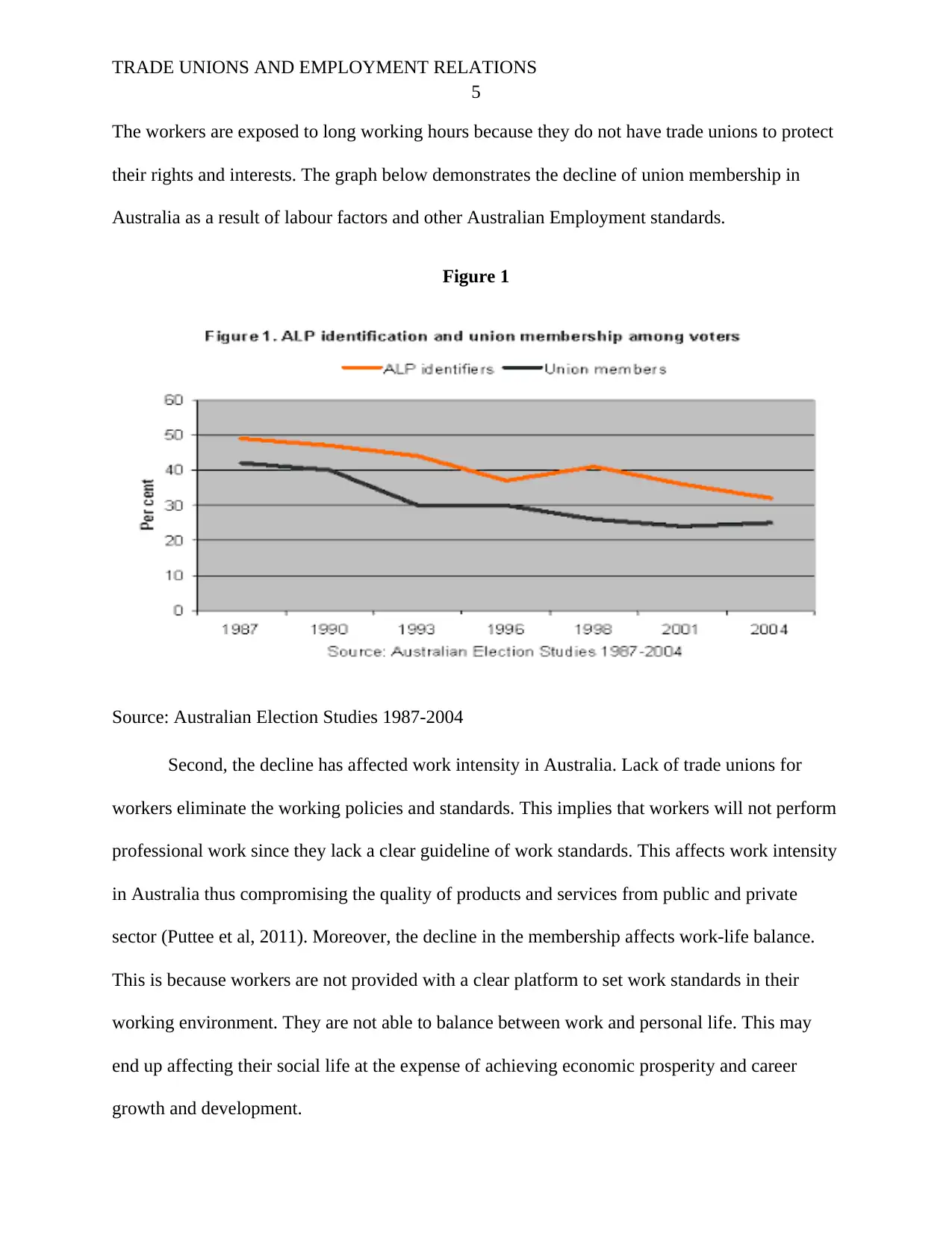
TRADE UNIONS AND EMPLOYMENT RELATIONS
5
The workers are exposed to long working hours because they do not have trade unions to protect
their rights and interests. The graph below demonstrates the decline of union membership in
Australia as a result of labour factors and other Australian Employment standards.
Figure 1
Source: Australian Election Studies 1987-2004
Second, the decline has affected work intensity in Australia. Lack of trade unions for
workers eliminate the working policies and standards. This implies that workers will not perform
professional work since they lack a clear guideline of work standards. This affects work intensity
in Australia thus compromising the quality of products and services from public and private
sector (Puttee et al, 2011). Moreover, the decline in the membership affects work-life balance.
This is because workers are not provided with a clear platform to set work standards in their
working environment. They are not able to balance between work and personal life. This may
end up affecting their social life at the expense of achieving economic prosperity and career
growth and development.
5
The workers are exposed to long working hours because they do not have trade unions to protect
their rights and interests. The graph below demonstrates the decline of union membership in
Australia as a result of labour factors and other Australian Employment standards.
Figure 1
Source: Australian Election Studies 1987-2004
Second, the decline has affected work intensity in Australia. Lack of trade unions for
workers eliminate the working policies and standards. This implies that workers will not perform
professional work since they lack a clear guideline of work standards. This affects work intensity
in Australia thus compromising the quality of products and services from public and private
sector (Puttee et al, 2011). Moreover, the decline in the membership affects work-life balance.
This is because workers are not provided with a clear platform to set work standards in their
working environment. They are not able to balance between work and personal life. This may
end up affecting their social life at the expense of achieving economic prosperity and career
growth and development.
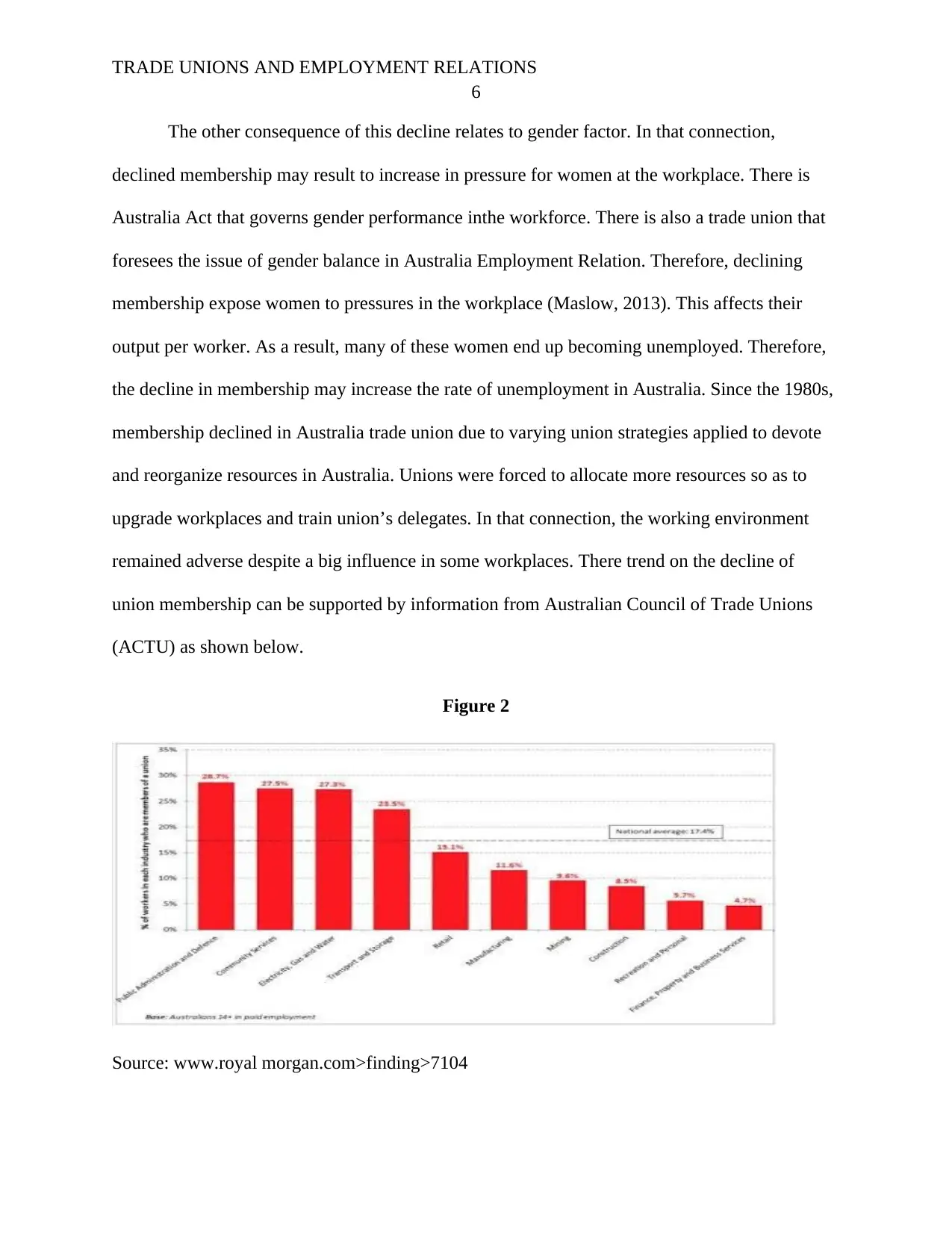
TRADE UNIONS AND EMPLOYMENT RELATIONS
6
The other consequence of this decline relates to gender factor. In that connection,
declined membership may result to increase in pressure for women at the workplace. There is
Australia Act that governs gender performance inthe workforce. There is also a trade union that
foresees the issue of gender balance in Australia Employment Relation. Therefore, declining
membership expose women to pressures in the workplace (Maslow, 2013). This affects their
output per worker. As a result, many of these women end up becoming unemployed. Therefore,
the decline in membership may increase the rate of unemployment in Australia. Since the 1980s,
membership declined in Australia trade union due to varying union strategies applied to devote
and reorganize resources in Australia. Unions were forced to allocate more resources so as to
upgrade workplaces and train union’s delegates. In that connection, the working environment
remained adverse despite a big influence in some workplaces. There trend on the decline of
union membership can be supported by information from Australian Council of Trade Unions
(ACTU) as shown below.
Figure 2
Source: www.royal morgan.com>finding>7104
6
The other consequence of this decline relates to gender factor. In that connection,
declined membership may result to increase in pressure for women at the workplace. There is
Australia Act that governs gender performance inthe workforce. There is also a trade union that
foresees the issue of gender balance in Australia Employment Relation. Therefore, declining
membership expose women to pressures in the workplace (Maslow, 2013). This affects their
output per worker. As a result, many of these women end up becoming unemployed. Therefore,
the decline in membership may increase the rate of unemployment in Australia. Since the 1980s,
membership declined in Australia trade union due to varying union strategies applied to devote
and reorganize resources in Australia. Unions were forced to allocate more resources so as to
upgrade workplaces and train union’s delegates. In that connection, the working environment
remained adverse despite a big influence in some workplaces. There trend on the decline of
union membership can be supported by information from Australian Council of Trade Unions
(ACTU) as shown below.
Figure 2
Source: www.royal morgan.com>finding>7104
⊘ This is a preview!⊘
Do you want full access?
Subscribe today to unlock all pages.

Trusted by 1+ million students worldwide

TRADE UNIONS AND EMPLOYMENT RELATIONS
7
Australia tried to stabilize the situation but trade union membership could not grow
significantly so as to correlate with workforce growth. As a result, trade union membership has
been associated with density decline. At present, Australia is facing difficulties in workplace
discrimination. Trade unions were acting as a representative for workers. Since the decline
started, workers are no longer represented equally in the workplace (Marylene, 2014). Therefore,
workers are being discriminated based on gender, religion, sex, and other forms of
discrimination. Workers do no longer enjoy trade union rights and privileges.
The other approach for the decline in membership relates to consequences of decline to
trade unions in Australia. Apart from workers being affected by the decline, trade unions also
face a difficult time as a result of membership decline. Being a member of a trade union, it is a
requirement to provide contributions to the union. Typically, workers are to pay for services
provided by their trade union. This implies that unions operate from funds contributed by
members. In that connection, upon exit as a member of a trade union, then the union loss a
portion of resources required to run day-to-day operations. Therefore, Australian trade unions are
facing financial crisis. This means they cannot operate effectively and efficiently. For example,
in the 1990s, Australian unions faced a challenge on workforce (Kanungo & Manuel, 2014).
Although workforce was increasing significantly, the rate of membership to trade unions
declined. This was contributed by the belligerence of employers and government on tribunal
advocacy and politics. The rate of decline in membership unions in Australia has been declining
a higher rate. The data below indicates the decline from 1990 to 2007.
7
Australia tried to stabilize the situation but trade union membership could not grow
significantly so as to correlate with workforce growth. As a result, trade union membership has
been associated with density decline. At present, Australia is facing difficulties in workplace
discrimination. Trade unions were acting as a representative for workers. Since the decline
started, workers are no longer represented equally in the workplace (Marylene, 2014). Therefore,
workers are being discriminated based on gender, religion, sex, and other forms of
discrimination. Workers do no longer enjoy trade union rights and privileges.
The other approach for the decline in membership relates to consequences of decline to
trade unions in Australia. Apart from workers being affected by the decline, trade unions also
face a difficult time as a result of membership decline. Being a member of a trade union, it is a
requirement to provide contributions to the union. Typically, workers are to pay for services
provided by their trade union. This implies that unions operate from funds contributed by
members. In that connection, upon exit as a member of a trade union, then the union loss a
portion of resources required to run day-to-day operations. Therefore, Australian trade unions are
facing financial crisis. This means they cannot operate effectively and efficiently. For example,
in the 1990s, Australian unions faced a challenge on workforce (Kanungo & Manuel, 2014).
Although workforce was increasing significantly, the rate of membership to trade unions
declined. This was contributed by the belligerence of employers and government on tribunal
advocacy and politics. The rate of decline in membership unions in Australia has been declining
a higher rate. The data below indicates the decline from 1990 to 2007.
Paraphrase This Document
Need a fresh take? Get an instant paraphrase of this document with our AI Paraphraser
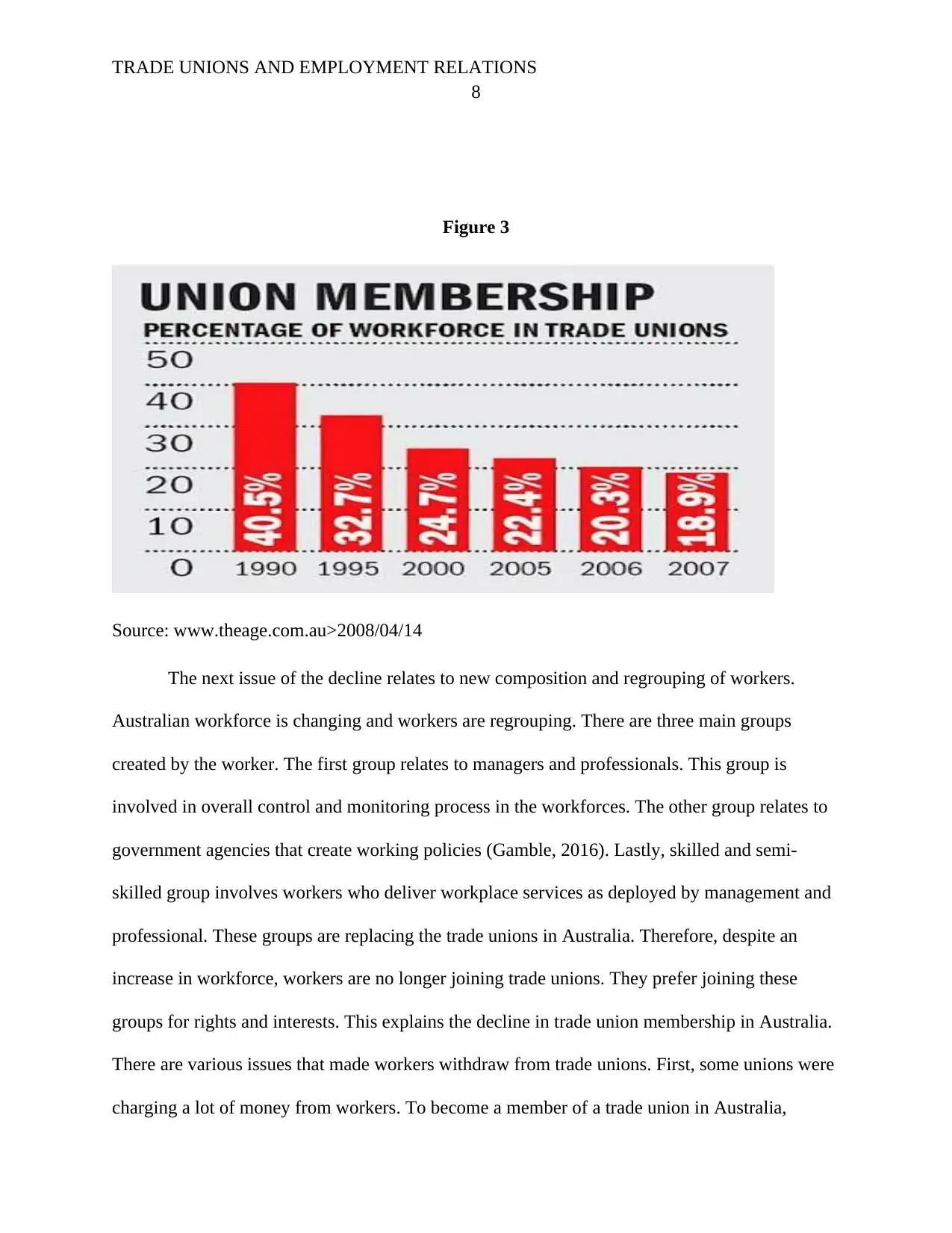
TRADE UNIONS AND EMPLOYMENT RELATIONS
8
Figure 3
Source: www.theage.com.au>2008/04/14
The next issue of the decline relates to new composition and regrouping of workers.
Australian workforce is changing and workers are regrouping. There are three main groups
created by the worker. The first group relates to managers and professionals. This group is
involved in overall control and monitoring process in the workforces. The other group relates to
government agencies that create working policies (Gamble, 2016). Lastly, skilled and semi-
skilled group involves workers who deliver workplace services as deployed by management and
professional. These groups are replacing the trade unions in Australia. Therefore, despite an
increase in workforce, workers are no longer joining trade unions. They prefer joining these
groups for rights and interests. This explains the decline in trade union membership in Australia.
There are various issues that made workers withdraw from trade unions. First, some unions were
charging a lot of money from workers. To become a member of a trade union in Australia,
8
Figure 3
Source: www.theage.com.au>2008/04/14
The next issue of the decline relates to new composition and regrouping of workers.
Australian workforce is changing and workers are regrouping. There are three main groups
created by the worker. The first group relates to managers and professionals. This group is
involved in overall control and monitoring process in the workforces. The other group relates to
government agencies that create working policies (Gamble, 2016). Lastly, skilled and semi-
skilled group involves workers who deliver workplace services as deployed by management and
professional. These groups are replacing the trade unions in Australia. Therefore, despite an
increase in workforce, workers are no longer joining trade unions. They prefer joining these
groups for rights and interests. This explains the decline in trade union membership in Australia.
There are various issues that made workers withdraw from trade unions. First, some unions were
charging a lot of money from workers. To become a member of a trade union in Australia,
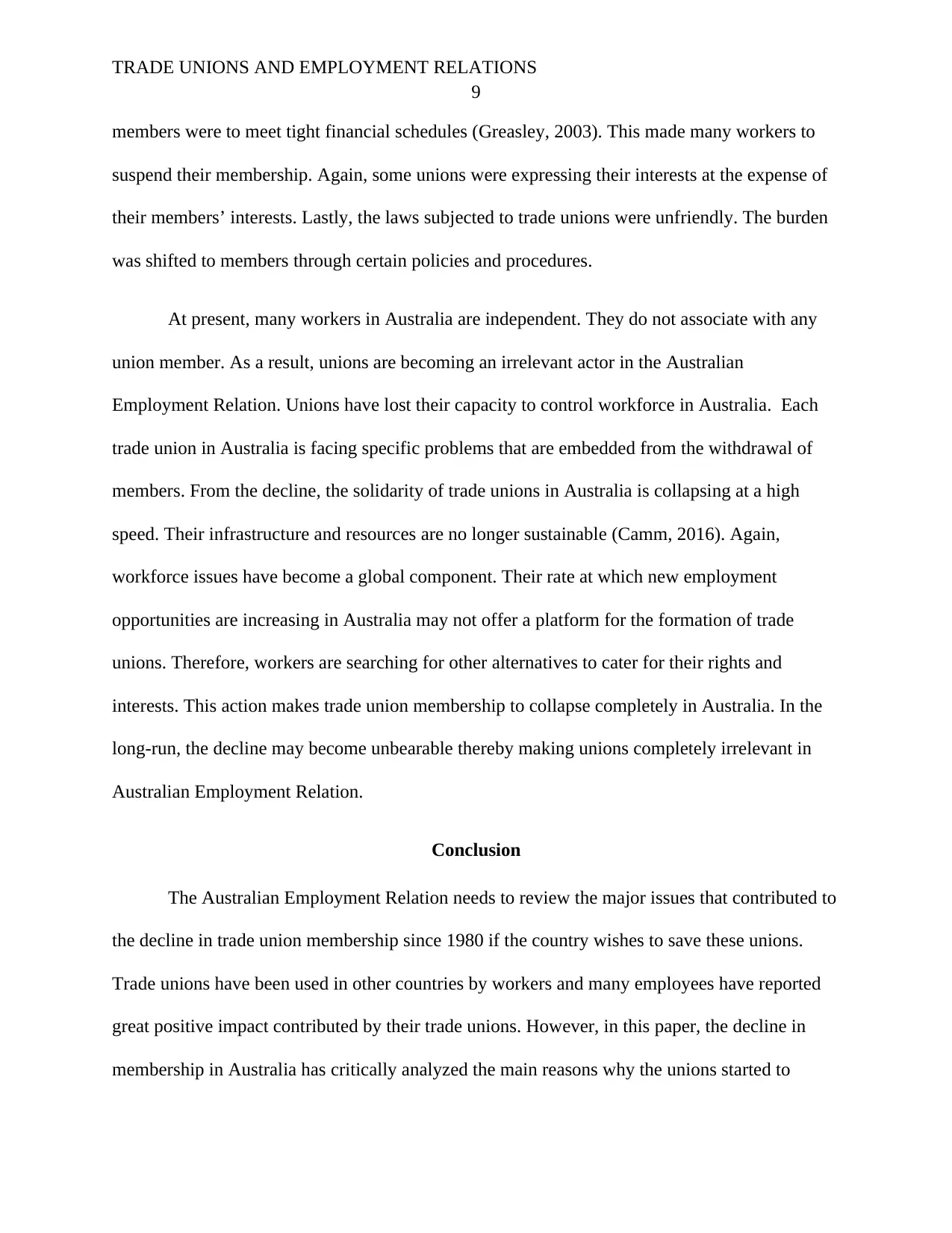
TRADE UNIONS AND EMPLOYMENT RELATIONS
9
members were to meet tight financial schedules (Greasley, 2003). This made many workers to
suspend their membership. Again, some unions were expressing their interests at the expense of
their members’ interests. Lastly, the laws subjected to trade unions were unfriendly. The burden
was shifted to members through certain policies and procedures.
At present, many workers in Australia are independent. They do not associate with any
union member. As a result, unions are becoming an irrelevant actor in the Australian
Employment Relation. Unions have lost their capacity to control workforce in Australia. Each
trade union in Australia is facing specific problems that are embedded from the withdrawal of
members. From the decline, the solidarity of trade unions in Australia is collapsing at a high
speed. Their infrastructure and resources are no longer sustainable (Camm, 2016). Again,
workforce issues have become a global component. Their rate at which new employment
opportunities are increasing in Australia may not offer a platform for the formation of trade
unions. Therefore, workers are searching for other alternatives to cater for their rights and
interests. This action makes trade union membership to collapse completely in Australia. In the
long-run, the decline may become unbearable thereby making unions completely irrelevant in
Australian Employment Relation.
Conclusion
The Australian Employment Relation needs to review the major issues that contributed to
the decline in trade union membership since 1980 if the country wishes to save these unions.
Trade unions have been used in other countries by workers and many employees have reported
great positive impact contributed by their trade unions. However, in this paper, the decline in
membership in Australia has critically analyzed the main reasons why the unions started to
9
members were to meet tight financial schedules (Greasley, 2003). This made many workers to
suspend their membership. Again, some unions were expressing their interests at the expense of
their members’ interests. Lastly, the laws subjected to trade unions were unfriendly. The burden
was shifted to members through certain policies and procedures.
At present, many workers in Australia are independent. They do not associate with any
union member. As a result, unions are becoming an irrelevant actor in the Australian
Employment Relation. Unions have lost their capacity to control workforce in Australia. Each
trade union in Australia is facing specific problems that are embedded from the withdrawal of
members. From the decline, the solidarity of trade unions in Australia is collapsing at a high
speed. Their infrastructure and resources are no longer sustainable (Camm, 2016). Again,
workforce issues have become a global component. Their rate at which new employment
opportunities are increasing in Australia may not offer a platform for the formation of trade
unions. Therefore, workers are searching for other alternatives to cater for their rights and
interests. This action makes trade union membership to collapse completely in Australia. In the
long-run, the decline may become unbearable thereby making unions completely irrelevant in
Australian Employment Relation.
Conclusion
The Australian Employment Relation needs to review the major issues that contributed to
the decline in trade union membership since 1980 if the country wishes to save these unions.
Trade unions have been used in other countries by workers and many employees have reported
great positive impact contributed by their trade unions. However, in this paper, the decline in
membership in Australia has critically analyzed the main reasons why the unions started to
⊘ This is a preview!⊘
Do you want full access?
Subscribe today to unlock all pages.

Trusted by 1+ million students worldwide

TRADE UNIONS AND EMPLOYMENT RELATIONS
10
collapse since the 1980s. Countries, where trade unions are successfully applied, tend to consider
the interests and rights of members as their first priority (Arnold, 2010). Therefore, if Australian
Employment Relation aims at re-energizing trade unions, it is high time to recommend unions to
operate differently. Right and interests of members should be prioritized. Otherwise, the decline
will reach an adverse level thereby making Australian Employment Relation irrelevant. All
stakeholders need to start working together to deliver quality services to their members. Lastly,
Australian Government needs to enact friendly laws in order to support trade unions. This will
contributes to the recovery of trade unions thus increasing the possibility of recruiting more
members in the future.
10
collapse since the 1980s. Countries, where trade unions are successfully applied, tend to consider
the interests and rights of members as their first priority (Arnold, 2010). Therefore, if Australian
Employment Relation aims at re-energizing trade unions, it is high time to recommend unions to
operate differently. Right and interests of members should be prioritized. Otherwise, the decline
will reach an adverse level thereby making Australian Employment Relation irrelevant. All
stakeholders need to start working together to deliver quality services to their members. Lastly,
Australian Government needs to enact friendly laws in order to support trade unions. This will
contributes to the recovery of trade unions thus increasing the possibility of recruiting more
members in the future.
Paraphrase This Document
Need a fresh take? Get an instant paraphrase of this document with our AI Paraphraser
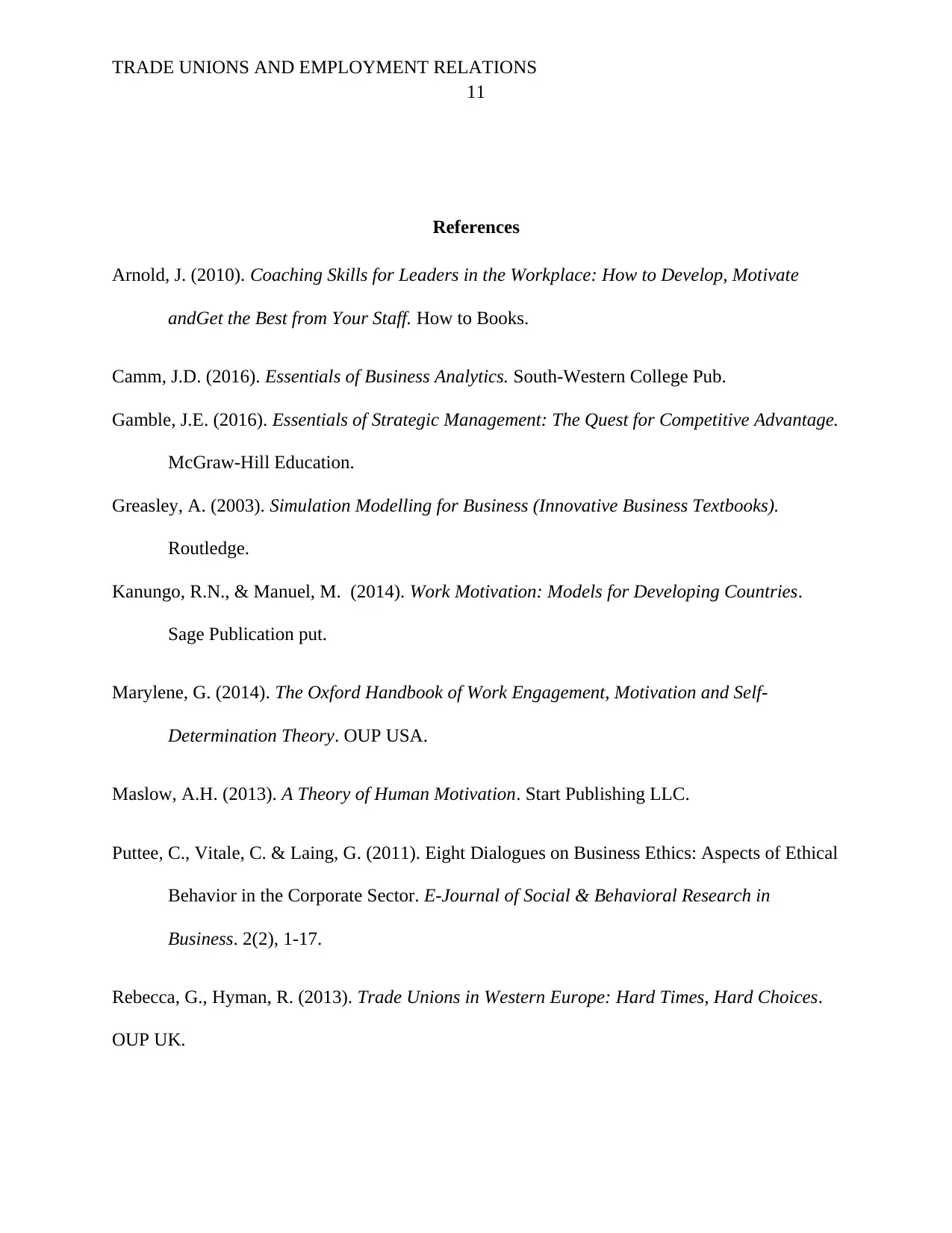
TRADE UNIONS AND EMPLOYMENT RELATIONS
11
References
Arnold, J. (2010). Coaching Skills for Leaders in the Workplace: How to Develop, Motivate
andGet the Best from Your Staff. How to Books.
Camm, J.D. (2016). Essentials of Business Analytics. South-Western College Pub.
Gamble, J.E. (2016). Essentials of Strategic Management: The Quest for Competitive Advantage.
McGraw-Hill Education.
Greasley, A. (2003). Simulation Modelling for Business (Innovative Business Textbooks).
Routledge.
Kanungo, R.N., & Manuel, M. (2014). Work Motivation: Models for Developing Countries.
Sage Publication put.
Marylene, G. (2014). The Oxford Handbook of Work Engagement, Motivation and Self-
Determination Theory. OUP USA.
Maslow, A.H. (2013). A Theory of Human Motivation. Start Publishing LLC.
Puttee, C., Vitale, C. & Laing, G. (2011). Eight Dialogues on Business Ethics: Aspects of Ethical
Behavior in the Corporate Sector. E-Journal of Social & Behavioral Research in
Business. 2(2), 1-17.
Rebecca, G., Hyman, R. (2013). Trade Unions in Western Europe: Hard Times, Hard Choices.
OUP UK.
11
References
Arnold, J. (2010). Coaching Skills for Leaders in the Workplace: How to Develop, Motivate
andGet the Best from Your Staff. How to Books.
Camm, J.D. (2016). Essentials of Business Analytics. South-Western College Pub.
Gamble, J.E. (2016). Essentials of Strategic Management: The Quest for Competitive Advantage.
McGraw-Hill Education.
Greasley, A. (2003). Simulation Modelling for Business (Innovative Business Textbooks).
Routledge.
Kanungo, R.N., & Manuel, M. (2014). Work Motivation: Models for Developing Countries.
Sage Publication put.
Marylene, G. (2014). The Oxford Handbook of Work Engagement, Motivation and Self-
Determination Theory. OUP USA.
Maslow, A.H. (2013). A Theory of Human Motivation. Start Publishing LLC.
Puttee, C., Vitale, C. & Laing, G. (2011). Eight Dialogues on Business Ethics: Aspects of Ethical
Behavior in the Corporate Sector. E-Journal of Social & Behavioral Research in
Business. 2(2), 1-17.
Rebecca, G., Hyman, R. (2013). Trade Unions in Western Europe: Hard Times, Hard Choices.
OUP UK.
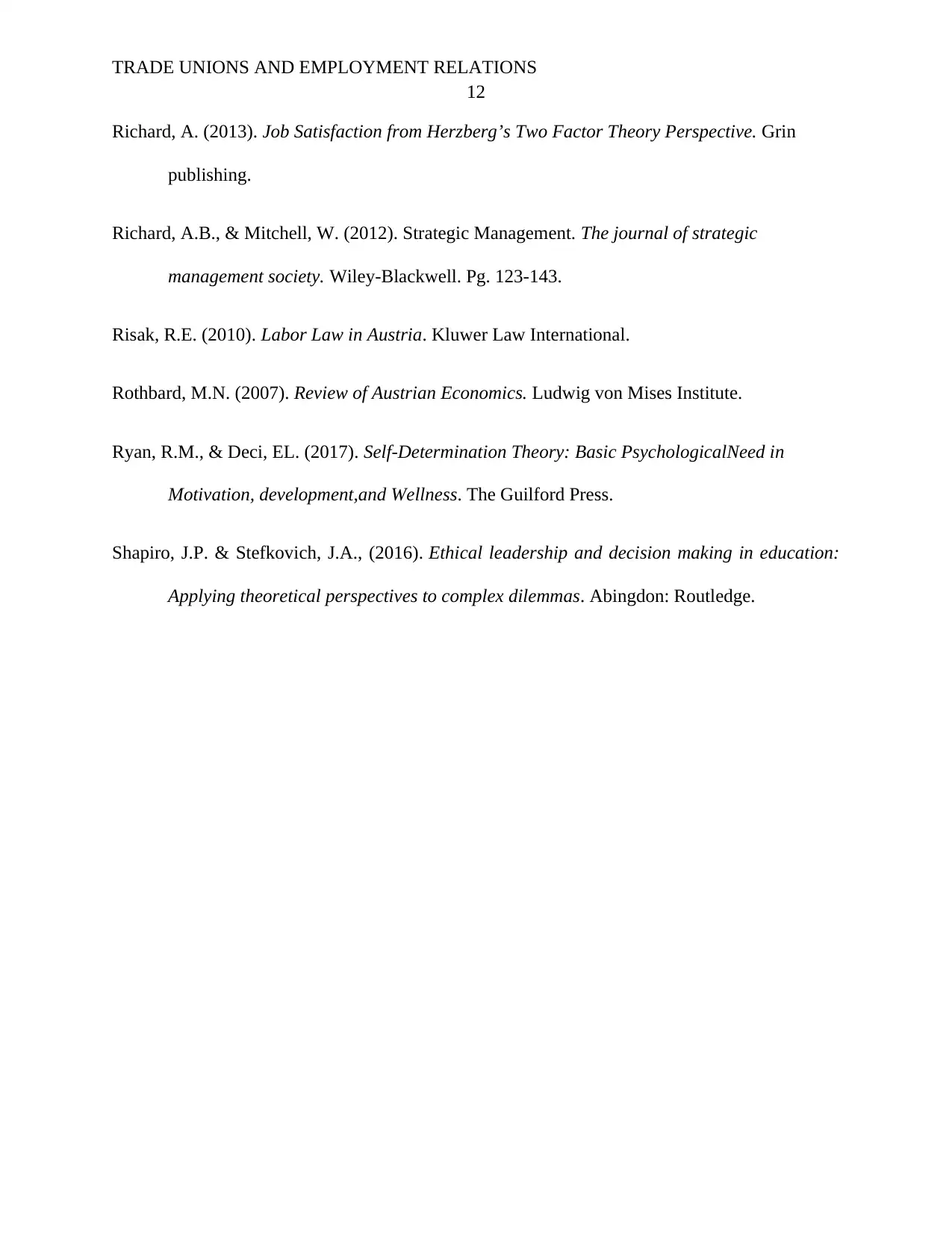
TRADE UNIONS AND EMPLOYMENT RELATIONS
12
Richard, A. (2013). Job Satisfaction from Herzberg’s Two Factor Theory Perspective. Grin
publishing.
Richard, A.B., & Mitchell, W. (2012). Strategic Management. The journal of strategic
management society. Wiley-Blackwell. Pg. 123-143.
Risak, R.E. (2010). Labor Law in Austria. Kluwer Law International.
Rothbard, M.N. (2007). Review of Austrian Economics. Ludwig von Mises Institute.
Ryan, R.M., & Deci, EL. (2017). Self-Determination Theory: Basic PsychologicalNeed in
Motivation, development,and Wellness. The Guilford Press.
Shapiro, J.P. & Stefkovich, J.A., (2016). Ethical leadership and decision making in education:
Applying theoretical perspectives to complex dilemmas. Abingdon: Routledge.
12
Richard, A. (2013). Job Satisfaction from Herzberg’s Two Factor Theory Perspective. Grin
publishing.
Richard, A.B., & Mitchell, W. (2012). Strategic Management. The journal of strategic
management society. Wiley-Blackwell. Pg. 123-143.
Risak, R.E. (2010). Labor Law in Austria. Kluwer Law International.
Rothbard, M.N. (2007). Review of Austrian Economics. Ludwig von Mises Institute.
Ryan, R.M., & Deci, EL. (2017). Self-Determination Theory: Basic PsychologicalNeed in
Motivation, development,and Wellness. The Guilford Press.
Shapiro, J.P. & Stefkovich, J.A., (2016). Ethical leadership and decision making in education:
Applying theoretical perspectives to complex dilemmas. Abingdon: Routledge.
⊘ This is a preview!⊘
Do you want full access?
Subscribe today to unlock all pages.

Trusted by 1+ million students worldwide
1 out of 12
Related Documents
Your All-in-One AI-Powered Toolkit for Academic Success.
+13062052269
info@desklib.com
Available 24*7 on WhatsApp / Email
![[object Object]](/_next/static/media/star-bottom.7253800d.svg)
Unlock your academic potential
Copyright © 2020–2025 A2Z Services. All Rights Reserved. Developed and managed by ZUCOL.





